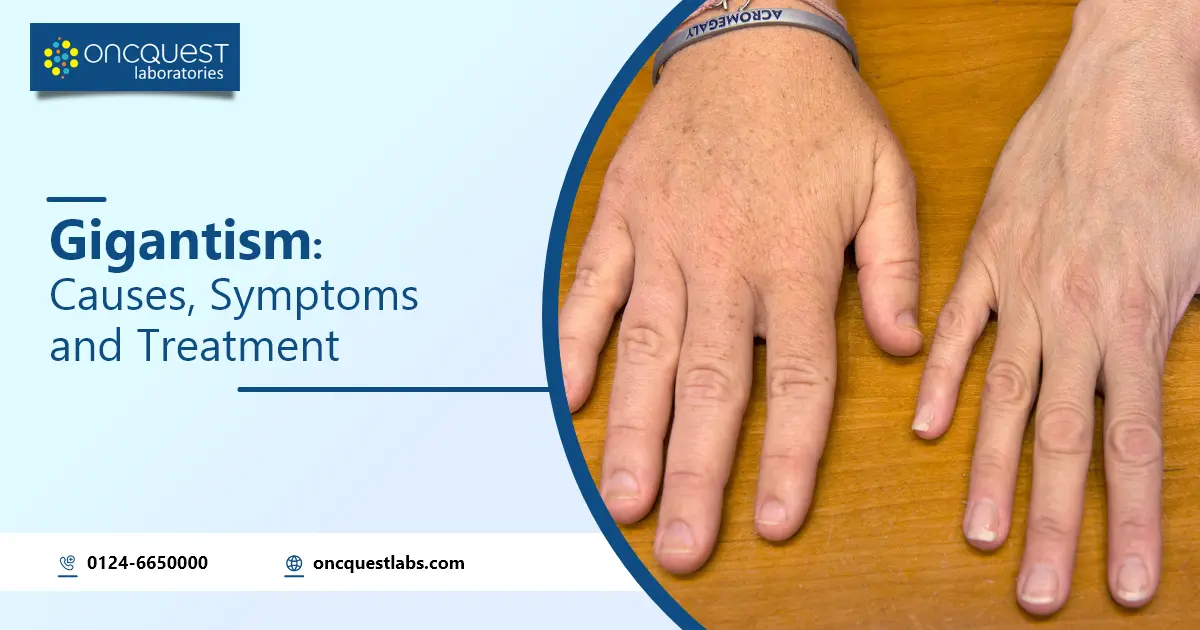Gigantism is a rare condition that occurs when a child or teenager has elevated levels of growth hormone, leading to excessive height. Early diagnosis is essential for effective treatment and to avoid complications associated with excessive growth.
Contents
- 1 What is gigantism?
- 2 Distinguishing Between Gigantism and Acromegaly
- 3 Who Is Affected by Gigantism?
- 4 Normal Growth Process in Children
- 5 Symptoms and Causes of Gigantism
- 6 Diagnosing Gigantism
- 7 Tests for Diagnosing Gigantism
- 8 How is gigantism treated?
- 9 Possible Complications of Gigantism Treatment
- 10 Prognosis for Gigantism
- 11 Life Expectancy of Individuals with Gigantism
- 12 Frequently asked Questions
What is gigantism?
Gigantism is a very rare condition that occurs in kids or teenagers when they have too much of a hormone called growth hormone (GH). This hormone makes them grow much taller than usual. Usually, the pituitary gland in the brain makes GH, but sometimes a tumor in the pituitary gland can make too much GH, leading to gigantism.
The pituitary gland is a small gland in the brain that makes many important hormones, including GH. Growth hormone, also known as human growth hormone (hGH) or somatotropin, helps kids grow by acting on different parts of the body. It mainly works to increase height until the growth plates in the bones stop growing. After that, GH helps keep bones, cartilage, organs, and metabolism normal.
In gigantism, too much GH causes muscles, bones, and connective tissues to grow rapidly. This excessive growth leads to much taller height than usual and can also cause changes in soft tissues. If gigantism isn’t treated, some people can grow to be over 8 feet tall, which can cause health problems.
That’s why it’s really important to diagnose and treat gigantism early to prevent excessive height and manage other health issues.
Distinguishing Between Gigantism and Acromegaly
Gigantism and acromegaly both happen due to too much growth hormone (GH), but they affect different age groups. Gigantism is seen in kids and teens who are still growing, while acromegaly occurs in adults.
In kids, gigantism occurs when they have too much GH before their bones stop growing (before puberty ends). Once their bones stop growing, excess GH leads to acromegaly. In acromegaly, you don’t get taller, but the extra GH can change the shape of your bones and affect the size of your organs, among other health issues.
Gigantism is much less common compared to acromegaly.
Who Is Affected by Gigantism?
Gigantism is extremely uncommon but can happen to any child whose bones are still growing (before they finish puberty). It’s more likely to affect boys than girls. Overall, gigantism is very rare.
Normal Growth Process in Children
Growth hormone (GH) helps kids grow by building bones, muscles, and tissues and controlling how their bodies use energy. This growth usually happens steadily until they hit puberty.
During puberty, the body starts making more sex hormones like estrogen and testosterone. These hormones make the growth plates at the ends of bones slowly close, which stops height growth once puberty ends.
How fast a child grows and how tall they end up depends on a mix of genes from their parents, things in their environment, and whether they are a boy or girl.
In gigantism, a child grows really fast and much taller than other kids their age and gender. Sometimes, parents might not notice it early because it might look like normal growth spurts.
If you’re worried about how fast your child is growing, it’s a good idea to talk to their doctor.
Symptoms and Causes of Gigantism
Signs and Symptoms of Gigantism:
1. Excessive growth in height is the main sign.
2. Physical features can include a prominent forehead and jaw, gaps between teeth, thickening of facial features, and large hands and feet.
3. Other symptoms may include enlargement of internal organs, excessive sweating, double vision or vision problems, headaches, joint pain, delayed puberty, irregular menstruation, sleep problems like sleep apnea, and muscle weakness.
Causes of Gigantism:
1. The primary cause is a benign tumor (pituitary adenoma) on the pituitary gland that releases too much growth hormone (GH).
2. Gigantism can also be caused by pituitary hyperplasia, where the pituitary gland becomes enlarged.
3. Genetic mutations, such as AIP gene mutations or deletions, are common in people with gigantism.
4. Gigantism can be part of rare genetic disorders like Carney complex, McCune-Albright syndrome, multiple endocrine neoplasias (MEN) type 1 or type 4, neurofibromatosis, and familial isolated pituitary adenomas (FIPA).
Diagnosing Gigantism
1. Gigantism is challenging to diagnose due to its rarity and variations in growth rates influenced by genetics and environment.
2. Healthcare providers suspect gigantism when a child’s height is three standard deviations above the normal average for their age and sex or two standard deviations above the adjusted average based on their biological parents’ height.
3. If gigantism is suspected, the healthcare provider will likely refer the child to an endocrinologist, a specialist in hormone-related conditions.
4. The diagnosis involves a thorough assessment of the child’s medical and family history, a clinical evaluation, and specialized tests like blood tests and imaging studies.
Tests for Diagnosing Gigantism
1. Growth hormone and IGF-1 blood tests: These measure hormone levels in the blood to check for elevated levels, which could indicate gigantism.
2. Glucose tolerance test: This assesses how your child’s growth hormone levels respond to glucose by taking blood samples at intervals after drinking a sugar solution.
3. Imaging tests: MRI or CT scans may be recommended to visualize and locate pituitary tumors, helping with treatment decisions.
Additional Tests for Gigantism:
1. Echocardiogram: Checks for heart issues due to gigantism.
2. Sleep studies: Used to detect sleep apnea, a common problem in gigantism.
3. X-rays or DEXA scan: These assess bone health, important in gigantism due to rapid growth.
How is gigantism treated?
Treatment Goals for Gigantism:
1. Control growth hormone (GH) and insulin-like growth factor 1 (IGF1) levels safely.
2. Manage the growth of pituitary tumors.
3. Reduce the impact of the tumor on surrounding structures like brain tissue and the optic nerve.
4. Address the effects of excess GH on other body systems.
Treatment Approaches for Gigantism:
1. Surgery: The primary treatment involves removing or reducing the size of the pituitary tumor. Multiple surgeries may be necessary due to the size of these tumors.
2. Radiation Therapy: When surgery isn’t sufficient, radiation therapy can be used to lower GH levels. It targets the tumor with radiation beams, although it works slowly and may take years to fully take effect.
Note: Medications used for acromegaly in adults haven’t been well-studied for children with gigantism.
Possible Complications of Gigantism Treatment
Complications and Risks of Gigantism Treatment:
1. Hypopituitarism: Around 60% of individuals treated for gigantism develop hypopituitarism, which requires hormone replacement therapy.
2. Surgery Complications: Surgical removal of pituitary tumors can lead to bleeding, cerebrospinal fluid leaks, meningitis, and sodium-water imbalance.
3. Radiation Therapy Risks: Possible side effects include impaired fertility, vision loss, brain injury (rare), and rare cases of tumor development years after treatment.
Prevention of Gigantism:
Unfortunately, gigantism cannot be prevented, but early diagnosis is crucial. Timely treatment can help manage excessive growth and associated complications.
Prognosis for Gigantism
The outlook for kids with gigantism depends on:
1. How early they’re diagnosed.
2. How well treatment controls growth hormone levels.
3. If they have any complications from gigantism.
Generally, kids diagnosed later may have more issues due to longer exposure to excess hormones. It’s important to talk to a doctor if you see unusual changes in your child’s growth or appearance.
Life Expectancy of Individuals with Gigantism
Complications of Gigantism:
1. Mobility problems from weak muscles.
2. Joint problems like osteoarthritis.
3. Nerve issues in the limbs (peripheral neuropathy).
4. Trouble breathing during sleep (sleep apnea).
5. Enlarged heart and heart valve problems.
6. Metabolic issues like Type 2 diabetes.
7. Difficulty with everyday tasks like buying clothes and traveling due to extreme height, impacting quality of life.
Frequently asked Questions
Q1: What is gigantism caused by?
A1: Gigantism is primarily caused by a benign tumor on the pituitary gland, leading to excess production of growth hormone (GH).
Q2: What is the most common treatment for gigantism?
A2: The most common treatment for gigantism is surgery to remove or reduce the size of the pituitary tumor causing the excess growth hormone production.
Q3: What is the cause of acromegaly?
A3: Acromegaly is caused by a benign tumor (usually a pituitary adenoma) on the pituitary gland that secretes excess growth hormone (GH).





